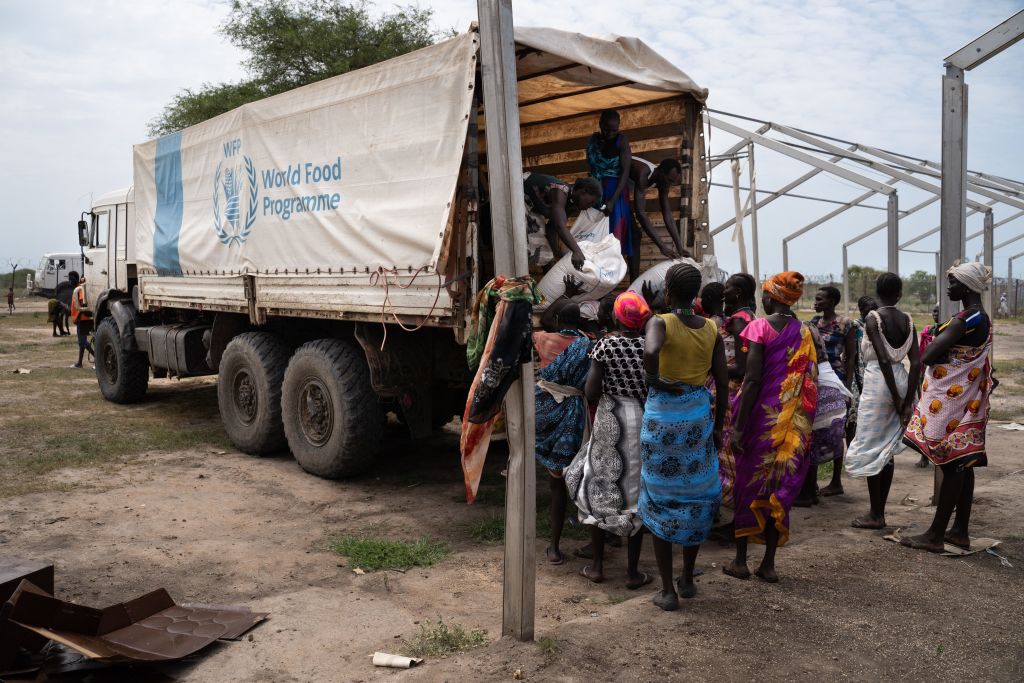ADF STAFF
The vicious cycle of conflict and hunger continues in some of Africa’s war-torn regions. Nowhere was it worse in 2023 than in Burkina Faso, Mali, Somalia and South Sudan.
They are the only countries in the world designated as Phase 5, described as catastrophe/famine — the most severe level in the Integrated Food Security Phase Classification (IPC) system.
Speaking to the United Nations Security Council, U.N. Famine Prevention and Response Coordinator Reena Ghelani emphasized that conflict and insecurity remain key drivers of hunger and famine.
“It is a man-made crisis that has been swelling for years,” she said in August. “We are now at a tipping point.”
The number of Africans facing acute food insecurity rose from 137 million in 2022 to a record 149 million in 2023. An estimated 82% of them are in conflict-affected countries. The IPC system defines acute food insecurity as Phase 3 or higher.
Nicholas Haan, creator of the IPC scale, said famine is when more than 20% of a population can’t secure enough food to sustain themselves.
“Famine is a complete collapse of the system,” he said. “It’s not just a food issue. The whole society is collapsing. It’s a health issue. It’s a water issue. It’s a sanitation issue.
“It’s a protection issue, because in such extreme environments people are highly vulnerable to exploitation and violence of all kinds.”
As of August 2023, the number of people in IPC Phase 3 or above included 2.7 million Kenyans, 3.7 million Somalis, 7.7 million South Sudanese, 20.3 million Sudanese, 990,000 Tanzanians and 582,000 Ugandans.
Famine has not been officially declared in Burkina Faso, Mali, Somalia or South Sudan, but they are teetering on the brink.
Burkina Faso
The World Food Program (WFP) estimated that 3.4 million Burkinabe — 15% of the population — faced the IPC Phase 3, the crisis level of acute food insecurity, or worse during the lean season between June and August 2023.
About 605,000 people in Burkina Faso’s Boucle du Mouhoun, Centre-Nord, Est, Nord and Sahel regions are experiencing emergency levels of hunger (Phase 4). The nation’s Sahel region also was projected to have about 43,000 additional people dealing with catastrophe/famine (Phase 5) levels of hunger.
“In these regions, people are driven into acute food insecurity due to rampantly high levels of violence, conflict-related displacement and siege tactics by armed groups depriving the population from access to humanitarian assistance,” the WFP said.
Mali
With violent extremist organizations expanding their reach in the center and eastern regions, about 1.3 million Malians are facing crisis or worse levels of hunger. The WFP says that nearly 1.48 million children under age 5 suffer from acute malnutrition, a 20% increase compared to 2022.
Insecurity and displacement continue to rise as the ruling military junta has mobilized troops to face Tuareg rebels in the North.
In the tri-border area, also known as the Liptako-Gourma region where Mali borders Burkina Faso and Niger, more than 76,000 people face emergency (Phase 4) levels of hunger. About 2,500 people in the Ménaka region are suffering from Phase 5 levels.
Somalia
Government forces, an African Union-led regional force called ATMIS, and allied militias remain locked in battle with al-Shabaab terrorists, who are linked to al-Qaida.
The insurgents are deeply embedded in large swaths of the central and southern regions, making humanitarian aid nearly impossible to deliver. The U.N. estimates that at least 3.8 million Somalis are internally displaced.
The WFP says about 40% of the population, nearly 6.6 million people, experienced crisis levels of food insecurity or worse through June.
South Sudan
Between April and June, 63% of all South Sudanese (7.8 million people) dealt with acute levels of hunger, including 2.9 million people who experienced emergency (Phase 4) levels throughout the country and 43,000 who faced catastrophe (Phase 5) levels in Jonglei state.
“The situation is being driven by rising levels of subnational violence which also disrupt humanitarian delivery,” the WFP said.
Since the Sudan conflict began in April, nearly 293,000 South Sudanese returnees and Sudanese refugees have entered South Sudan, worsening an already severe humanitarian situation.
Speaking on World Food Day on October 16, U.N. Secretary-General António Guterres urged countries to act.
“The long-term causes of the global food crisis include conflicts, climate extremes, inequality and economic instability,” he said in a video.
“In 2015, after years of progress, governments set the goal of zero hunger by 2030. But eight years later, the number of people suffering from hunger has increased significantly. This crisis demands action.”

